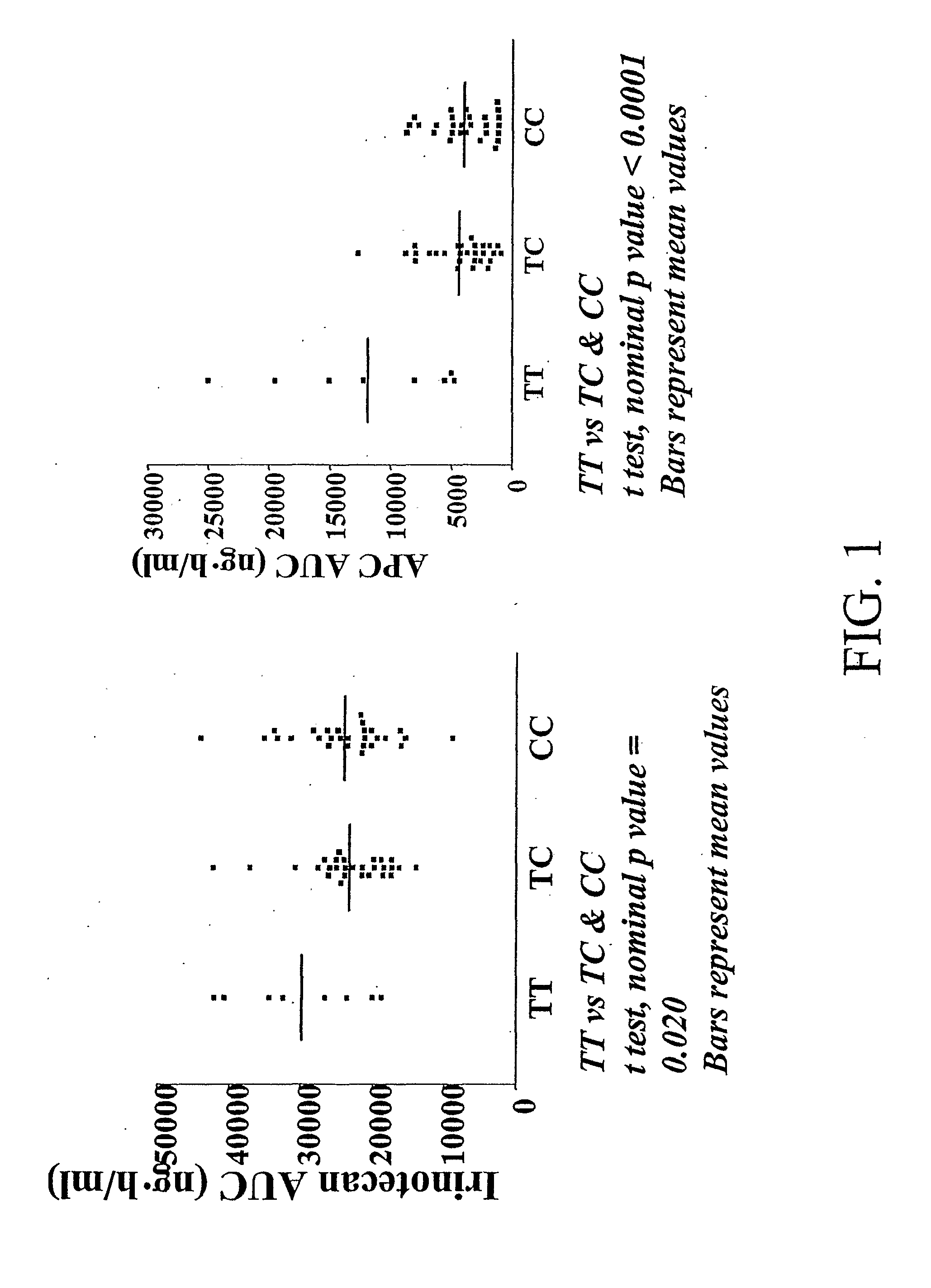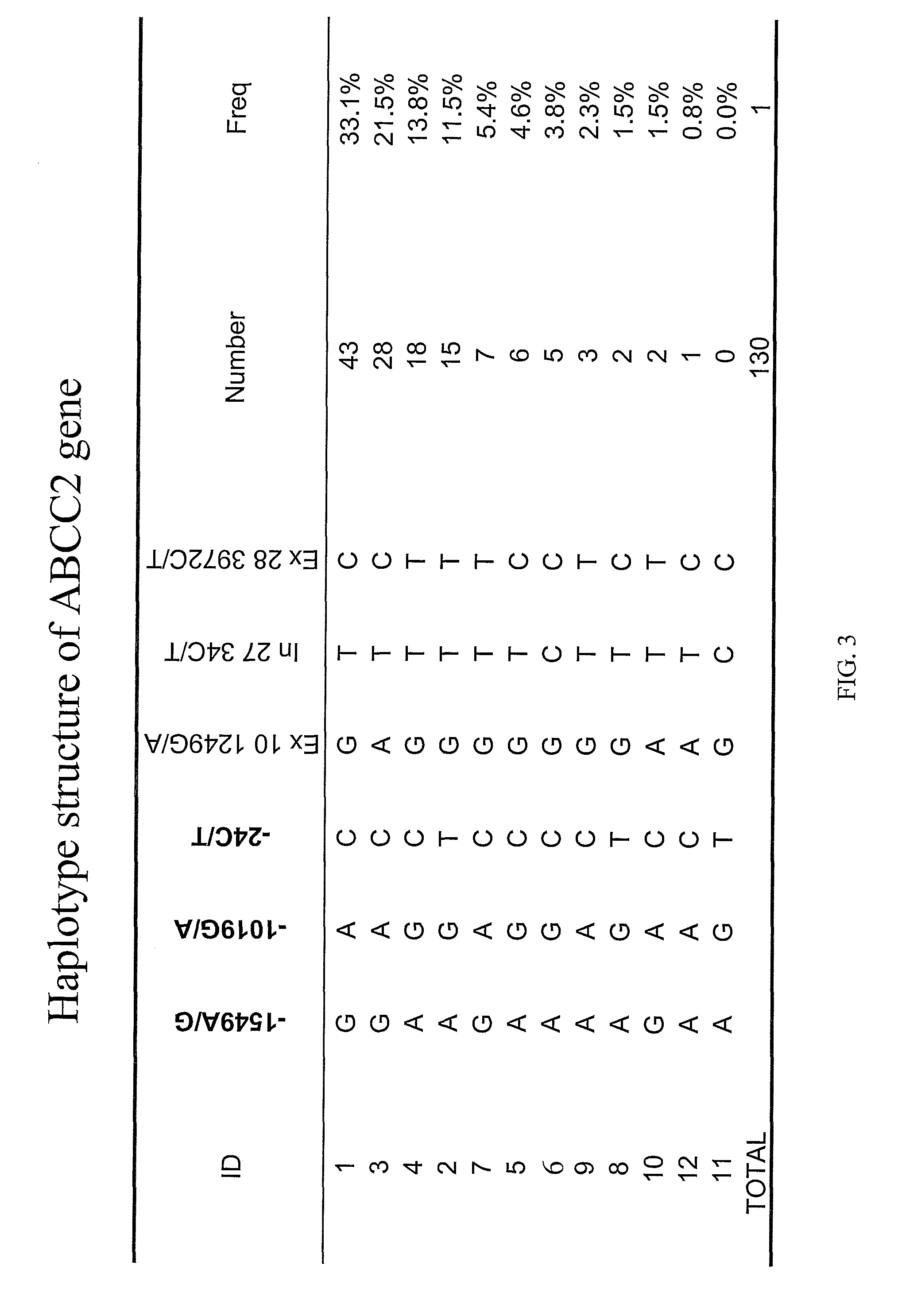Methods and compositions relating to pharmacogenetics of different gene variants in the context of irinotecan-based therapies
a technology of irinotecan and gene variants, applied in the field of molecular genetics, pharmacogenetics, and cancer therapy, can solve the problems of significant toxicities of irinotecan treatment, abnormally high levels of unconjugated serum bilirubin, encephalopathy and kemicterus, etc., to reduce the chance of response of patients, reduce the cytotoxic activity of cancer cells, and reduce the antitumor
- Summary
- Abstract
- Description
- Claims
- Application Information
AI Technical Summary
Benefits of technology
Problems solved by technology
Method used
Image
Examples
example 1
Correlation of the 3972C>T Variant of ABCC2 with Irinotecan Pharmacokinetics
[0199]Sixty-four adults (48 Caucasians, 10 African-Americans, 4 Hispanics, and 2 others) with refractory solid tumors took part in the pharmacogenetic study. Genotyping of common variants (q>0.10 in individuals of African and Caucasian origin) was performed for the following genes (number of variants in parenthesis): CES-2 (n=2), ABCC1 (n=7), ABCC2 (n=6), ABCB1 (n=8), CYP3A4*1B (n=1), CYP3A5*3 (n=1), UGT1A9 (n=1), and HNF-1α (n−1) (Table 2).
TABLE 2Genetic variants typed in this study.GeneLocationPositionCES-216q22.1−363C > G, 5′UTRCES-216q22.11361G > A, intron 1ABCC116p13.11062T > C, synonymousABCC116p13.18A > G, intron 9ABCC116p13.1−48C>, intron 11ABCC116p13.11684T > C, synonymousABCC116p13.1−30C > G, intron 18ABCC116p13.14002G > A, synonymousABCC116p13.118A > G, intron 30ABCC210q24−1549(G > A), promoterABCC210q24−1019A > G, promoterABCC210q24−24C > T, 5′UTRABCC210q241249G > A, nonsynonymous, Val417IleABCC2...
example 2
Irinotecan (CPT-11) Pharmacokinetics (PK) and Neutropenia: Interaction Among UGT1A1 and Transporter Genes
[0202]In addition to the ABCC2 variants described above, several other ABCC2 variants have been shown to affect ABCC2 expression in vitro. The organic anion transporter polypeptide-1B1 (OATP-1B1, SLCO1B1) is involved in the liver uptake of several compounds. The effects of ABCC2 haplotypes and SLCO1B1 genotypes on CPT-11 PK and neutropenia were evaluated.
[0203]Methods: 65 patients previously assessed for pharmacokinetics and toxicity (Innocenti et al., 2004, which is incorporated by reference) were studied. Six SNPs in ABCC2 were genotyped [−1549G>A, −1019A>G, −24C>T, 1249G>A, intron 27-34C>T, 3972C>T] and haplotypes were estimated. Two SNPs in SLCO1B1 [*1b (388A>G) and *5 (521T>C)] were also genotyped.
[0204]Results:
[0205]Twelve ABCC2 haplotypes were identified, with haplotypes 2, 3, 4, 7, and 6 having a frequency of 0.33, 0.22, 0.14, 0.12, and 0.05, respectively. See FIG. 3 for ...
example 3
ABCC2 and UGT1A1 have Additive Effects on Neutropenia and Diarrhea
[0212]The indel TA repeats in the UGT1A1 promoter region were combined with ABCC2 haplotype 4 analysis to investigate a correlation with toxicity effects of irinotecan. As shown in FIG. 3, persons with the greatest risk of toxicity had neither a TA repeat of 6 or an ABCC2 haplotype 4. Persons with either an ABCC2 haplotype 4 or six TA repeats in the UGT1A1 gene had the lowest risk for toxicity. Thus, the effects of ABCC2 and UGT1A1 appear additive with respect to diarrhea and neutropenia.
PUM
| Property | Measurement | Unit |
|---|---|---|
| energy | aaaaa | aaaaa |
| resistance | aaaaa | aaaaa |
| multidrug resistance | aaaaa | aaaaa |
Abstract
Description
Claims
Application Information
 Login to View More
Login to View More - R&D
- Intellectual Property
- Life Sciences
- Materials
- Tech Scout
- Unparalleled Data Quality
- Higher Quality Content
- 60% Fewer Hallucinations
Browse by: Latest US Patents, China's latest patents, Technical Efficacy Thesaurus, Application Domain, Technology Topic, Popular Technical Reports.
© 2025 PatSnap. All rights reserved.Legal|Privacy policy|Modern Slavery Act Transparency Statement|Sitemap|About US| Contact US: help@patsnap.com



